Posted: May 6th, 2009 | Author: Shui Jing | Filed under: creative industries, real-estate | Tags: Ningbo | No Comments »
Keane (2009) believes that in China, creative industry park could divide into three types.
First of all, some creative industry parks close to the university. On one hand, they can anticipate the reputation of university to enhance creative park popularity. On the other hand, they can rely on creative talent and knowledge in college or university to improve quality of creative products. In Ningbo, the Innovation Valley is exactly a good case. In 2009, Innovation Valley and five surrounding universities such as Ningbo University and Ningbo Engineering College etc had signed contracts with Innovation Valley .Later they will develop their wisdom to Innovation Valley.
The second mode is the most common pattern and it is to preserve the old factory. To some extent, it has not only retained historical building, but also stimulated the imagination of artists. For example, Loft 8 in Ningbo was Ningbo Fangxiang Factory before.238 Creative Park was Ningbo Tianyi Toy Factory.
The last mode is the creative industry park and it is constructed with completely new. Generally, it is driven by government policy. This mode is also extremely wide spreading in Ningbo. Wealth and Creative Harbour, DIY City in Cichen were shaped by government planning.
On the whole, as Keane (2009) pointed out, through the operation from real estate developer, creative cluster had realized their real value in well organized on old buildings and city planning by real estate developer and government.
Van (2009) also proved that, social capital of creative industry took advantage from cluster. The transaction costs were reduced during face to face contact. For instance, search costs and process of bargaining were decreased.
Liu&Li(2006)have come to the conclusion that, the level of urbanization of Ningbo city is belonging to the forth rank. In other words, Ningbo has lower urbanization than other cities. They used spatial aggregation, economic development, social development these aspects to measure some sub-provincial cities like Ningbo. Cooke& Lazzeretti (2008) reports that, the higher level of urbanization result in intimate relationship with the world in creative industry. Therefore, as the present situation of Ningbo, Nie&Wang (2008) analyze on four aspects of problems that exist in Ningbo creative industry. Firstly, overvalue on business however overlook on culture. This is a problem appeared on concept aspect. Secondly, management confusion, this is a problem belonging to government system. Thirdly, creative industry is lack of policy to support, such as tax revenue and government grant. Finally, Ningbo creative industry is professionals’ scarcity that both on designer and manager.
References
Cooke,P&Lazzeretti,L(eds) 2008,Creative Cities, Cultural Clusters and Local Economic Development, Edward Elgar Publishing,UK.
Keane,M 2009, ‘Great adaptations: China’s creative clusters and the new social contract’, Journal of Media &Cultural Studies,vol.23,no.2,pp.221-230.
Liu, Yanjun&LI, Chenggu 2006, ‘Research on urbanization level of urban regional centres evaluation’, Journal of Economic Geography, vol.26, no.2, pp.225-229.
Nie, Jinglei& Wang,Qiuyan 2008 The Survey on Current Situation of Creative Industry and Development Stratagem in Ningbo. Journal of Market Modernization,Vol.561, no.12,pp.213-215.
Van Heur, Bas (forthcoming 2009) ‘The Clustering of Creative Networks: Between Myth and Reality’, Urban Studies 46.9.
Posted: May 6th, 2009 | Author: Meng Xing | Filed under: waste industries | Tags: e-waste, recycling | No Comments »
It is estimated that E-wastes are generated 20-50 million tonnes per year in the world (Greenpeace 2008). Nowadays, Because of the high tech, the life cycle of electronic equipment is shorter than before. The products update quickly. UNEP-Vital-Graphic (2004) reports that the computers have an average life span of only 2 years in developed countries. There are many problems in recycling and disposal of E-waste. Open burning of E-wastes is toxic because of hazardous and materials such as heavy metals and PVC which are harmful for environmental, animals and human health (Greenpeace 2008). The contamination of wastes has an impact on the surrounding soils. In China, Dumping and the open burning sites are still common.
As the research conducted by Greenpeace, the electronics products contain lead, Cadmium (can result in damage to the kidneys and bone toxicity), Antimony, Phthalates, PCBs, etc. UNEP-Vital-Graphics points out that there are about 23% plastic, 32% ferrous metals, 18% non-ferrous metals, 12% electronic boards and 15% glass in a computer. However, only about 50% of the computer can be recycled.
The regulation is necessary for controlling the environmental pollution. During designing and manufacturing, the use of hazardous chemicals should be avoided. Furthermore, although the imports of E-waste is banned, there are still a large amount of illegal E-wastes enter into China.
Greenpeace (2008) Chemical Contamination at E-waste Recycling and Disposal Sites in Accra and Korforidua, Ghana.
UNEP-Vital-Graphics (2004) Vital Waste Graphics. E-Waste: The Great E-waste Recycling Debate.
Posted: May 6th, 2009 | Author: Xu Shengxi | Filed under: creative industries | Tags: creative cluster, creative industry, urban spatial structure | No Comments »
Creative industry was established for solving problem of unemployment in post-industrial time, as Ned Rossiter (2008) mentioned in Creative China: Counter-Mapping Creative Industries’, it covers communication, advertising, music and urban developing areas which can be regarded as “new economyâ€. Compare to developed countries where has matured developing scale of creative industry like UK and Australia, China started to develop creative economy after Eleventh-Five Year Plan (ibid). The rise of creative industry in China leads to the emergence of a new form of economy which called creative economy (Hong 2006, p.38).
Although creative industry such as advertising and communication industry seem as sunrise industry in contemporary China and absorb numbers of young adults full of passion, it faces to many barriers and difficulties according to the reality of China. China is now experiencing a complicated transitional period in economic, urban and social areas (Rossiter, 2008, p. 25). As Adrian Blackwell (2008, p.50) considers there is a gap between “strong central government and weak regulatory frameworkâ€. To a certain degree it helps to promote the efficiency of socialist market economy operate in international market, however, disadvantages appear in many areas like urban spatial structure, urban-image building and even creativity of creative industries in China (Blackwell, A 2008, p.50& Chen, 2008, p.18).
The development of creative industry in China, to a certain degree, is becoming the pronoun of real estate. As Shaofeng Chen (2008, p.18), the assistant dean of Institute for Cultural Industries of Pecking University claims that there is a mistaken idea in the growth of creative clusters in China. He mentions that creative industry is usually operated as real estate program according to governmental policy about land supervision (ibid). It leads to the transition of creative cluster from Creative Park to Real Estate Park, and weakens cultural power as well as distorts the original meaning of cultural creativity though it brings economic profit (ibid). Professor Ned Rossiter (2008, p.52) considers big city like Beijing has its certain scale of creative industry, however, they contribute much more on driving price of real estate than on improving their creativities. Creative clusters seldom create new ideas; they even become image-program of government (Rossiter 2008, p.52 & Chen 2008, p.18).
Nevertheless, creative industry spring up in China result in positive transition of urban structure of China. In term of capital investment, it influences anthropology flow because creative industry gathers human ideas and creativities. As Professor Ned Rossiter (2008, p.24) claims that the restructure of various districts will happen in a certain scale. Adrian Blackwell (2008, p. 48) considers in today’s China there are two basic extensions mode of urban outer suburbs, which are “poorly controlled village intensification and expansive new development zonesâ€. In some cities which have a development scale of creative industry, like Beijing and Shanghai, the new economic form which have the basis of urban historical heritage create new profits, for instance 798 in Beijing and Tianzi Fang in Shanghai. This kind of urban heritage is labelled history and Chinese characteristics, moreover, they are reformed as the new artistic space for consumption. As the first creative cluster based on disused factory in Ningbo, Loft 8 gathers design studio, advertising company and DIY (do it yourself) space, etc. According to the introduction from Zane Zhu, the host of No Space in Loft 8, there are many artistic exhibitions taken there, such as paintings and photographs. The development of Loft 8 has its success, however, as Zane Zhu mentioned it still has inadequate attention from the public, and it hasn’t combined with commercial activities. In term of newly creative development zone, take the first creative technology park for example, it locates in Ningbo University Park and has access to get abundant recourses like soft company. It can be seen as “a cultural archipelago†(Blackwell 2008, p.48). Although there is a big distances between big cities where a large scale of creative development has, how can urban spatial structure achieve in Ningbo and to what extent can become reality? Ningbo has its advantages in location and economic development, moreover, its cultural background is profound. Does the creative cluster in Ningbo can contribute to the urban spatial restructure? To what extent they can? This is the question I want to evaluate in my essay.
Loft 8, Ningbo, based on disused factory
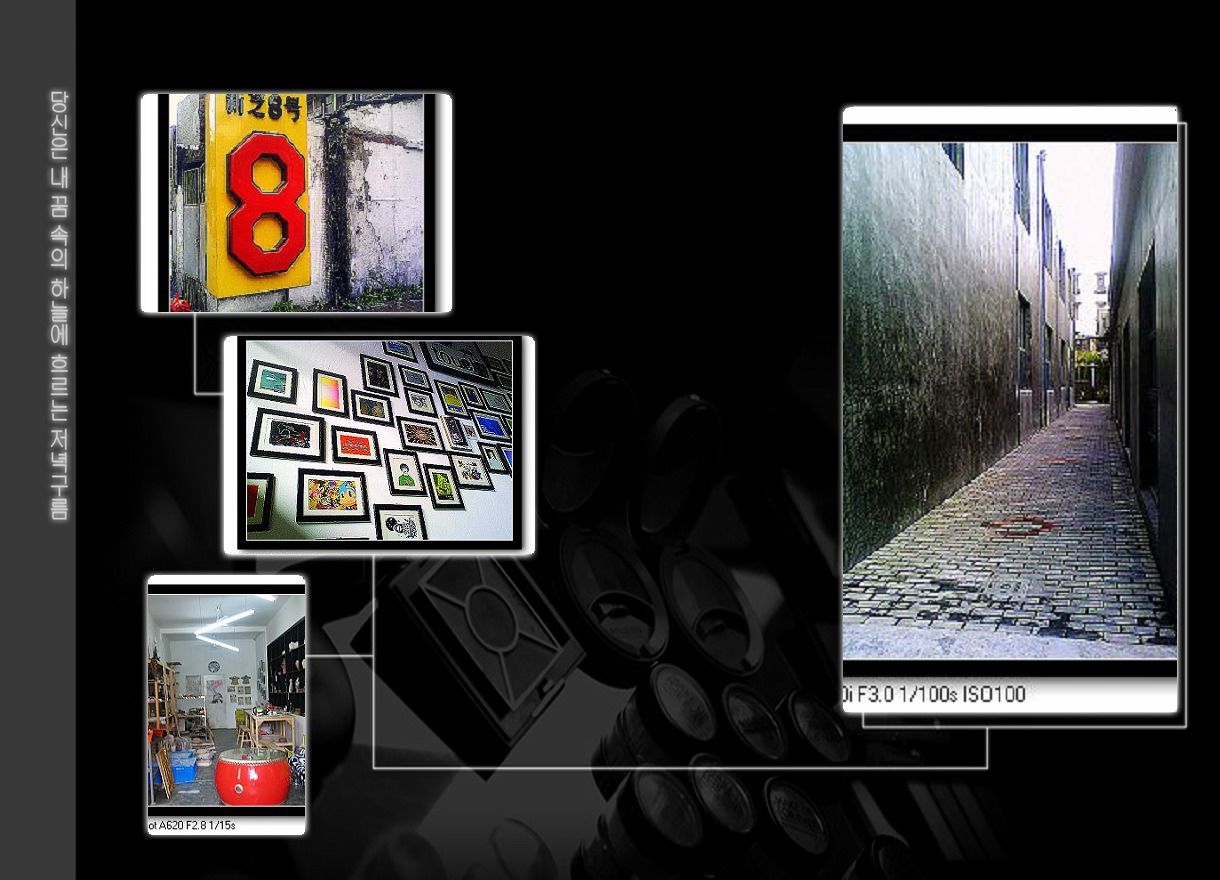
Tian Zi Fang, Shanghai, old alley but new creativity

References
Blackwell, Adrian (2008) ‘Inverting the Cultural Map: Peripheral Geographies of Beijing’s Creative Production’, Urban China 33: 48-51.
Carriço, Mónica; de Muynck, Bert; Rossiter, Ned (eds) (2008) Urban China 33 [Special Issue: ‘Creative China: Counter-Mapping Creative Industries’].
Chen, S F 2008, Ten Mistaken Ideas of Creative Clusters, China Academic Journal Electronic Publishing House.
Hong, L 2006, Creative Industry and Creative Economy, Friend, vol.10, pp.38-39.
Ned, R 2008, Informational Geographies vs. Creative Clusters, Urban China, vol.33, pp.32
Posted: May 5th, 2009 | Author: Meng Xing | Filed under: waste industries | Tags: ecopolitics, urban development | No Comments »
Zehle (2008) indicated the notion of “network ecologies”. Urban development in many cities of the world will be influenced by local, national and regional politics and institutions. Local and national politics have played the most important role in current urban development. Industrialization which is rapidly developing in China results in a mass consumerism through material gain. Zehle (2008) mentions that the recycling yards around Beijing are sprawling. Urban development needs resources and produces wastes.
According to Conley (1997), Ecopolitics is a study of environmental awareness – or non-awareness. It means that we think about the conditions of life, space and the world in an ecological way. Verena Andermatt Conley gave strong ecological consciousness which can make long-range effects. Ecopolitics poses questions to technologies and concerns with the environment.
Neo-industrialization in the new economy is an integral approach to economy, ecology and space and bringing in new activities. Although Hong Kong, Shanghai, and Beijing are well developed, Petersen (2003) argues that in the global market, Chinese companies lack competition because of the limits of capital, advanced technology, developed markets, and name brand recognition. It is hard to for Chinese companies to reduce costs and increase profits. Many national companies will take a risk of going bankrupt. This will result in social problems such as: unemployment. Furthermore, during the urban development, rural labor will be eager to move to the urban areas. However, their working condition and life quality are not optimistic.
Zehle S (2008) ‘Network Ecologies: Documenting Depletion, Exhausting Exposure‘, Urban China 33: 30-31.
Petersen K (2003) China,Neoliberalism,and the WTO.Retrieved April 26, 2009 from http://dissidentvoice.org/Articles7/Petersen_China-WTO.htm
Conley VA (1997) Ecopolitics: the environment in poststructuralist thought, Routledge, London. Retrieved April 26, 2009 from ebrary database.
Posted: May 5th, 2009 | Author: Shui Jing | Filed under: creative industries, real-estate, theory | No Comments »
According to Van (2009), at present, the network cluster formed with accumulation regime. Additionally, creative cluster is the sub-cluster from industrial clusters.
There are some connections between urban development and competitive power ,when one company was classifying into creative industry spatial agglomeration.
Van mentioned, originally, in Berlin, some real estate of important creative cluster was organized by shareholder project format. Afterwards, from 2004 it’s transformed into ‘regional management’. In other words, the government intervenes in this area and begins to corporate with real estate developer.
In London, even the spatial clusters were sorted out ambiguously, the tendency of creative cluster is exist.
Van also uses Maskell(2001) notes to analyze cluster and development in creative industry from the three aspects.
First of all, some firms are willing to relocate or partly relocate into cluster for potential customers in such area. For example, the Magazine of Urban China relocated their Shanghai Branch office instead of moving in one of creative industry park in Yangpu District.
In addition, some dominant tendency also will lead some firms to think about what sector of creative industry they should get involved in. Give an example, In Ningbo, the project of Industrial Design and Creative Park will give lots of opportunity for design studios and advertising companies. Owing to this creative park already have some relationships with manufacturing companies in Ningbo. According to Hu (2009), on account of the small medium scale manufactures in Ningbo had developed very well. However, if they want achieve better performance; the reality is that their ability is limited for reason of lack of industrial design skill. Therefore, in such situation, design studios in the Industrial Design and Creative Park will definitely have closed relationship with these enterprises. In other words, small medium scale manufactures could benefit from design and their products appearance will be showed in such creative park. In the end, products will get great demand. On the other hand, design studio also could through these designs to demonstrate their strength and gain money.
Finally, the phenomenon of new firms as the spin-offs in cluster becomes more and more common in daily life. Because of technical shift and commercialization, such companies are the good places for staff to expand their imagines and creativity. Do those company forms appear in Ningbo? Next step, I want to interview some persons and figure it out.
One of blueprint of Ningbo Industrial Design and Creative Park

Van Heur, Bas (forthcoming 2009) ‘The Clustering of Creative Networks: Between Myth and Reality’, Urban Studies 46.9.
Hu, Haizhong & Xiao Yingzhe 2009, ‘On interactive relationship between Ningbo constructing industrial park and developing small-medium scale manufactures’, Journal of Zhejiang Wanli University,vol.22,no.1,pp.83-86.
Posted: May 5th, 2009 | Author: Fu Hanqing | Filed under: creative industries | Tags: Ningbo museum | 1 Comment »
Ningbo museum is located in the south east district of Ningbo city, with an area of about 4 hectares, a floor area of about 30000 square meters and 16,000 collections. It is one of the eight cultural projects which Ningbo government majorly constructed. Drawing upon its two major advantages, creative architecture and creative exhibitions, Ningbo museum came to the fore in China which has all kinds of museums.
Ningbo Museum, 1000 Shounan Road (M), Yinzhou, Ningbo, China

Creative Architecture
The style of architecture of Ningbo Museum is called ‘new interpretative attitude’. The idea of this style do not venerate the unchanging design patterns but stress to use local materials and methods in design. Ningbo museum is laden with a lot of cultural information of Ningbo. First of all, Ningbo museum is architecture of ‘half mountains and half houses’. The building has a list to the south which symbolized the local landform of mountain. An expanse of water traverses the major entrance, rounding the whole building. It indicates the development of Ningbo from ferry to estuary and thence to port.
Expanse of Water & ‘half mountains and half houses’
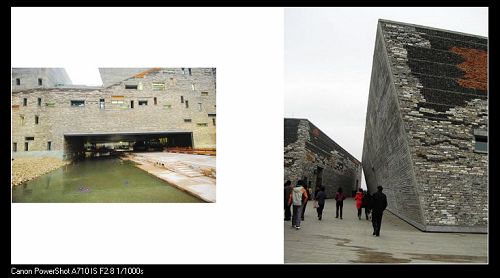
Secondly, the main attraction of this museum is the ‘tile wall’ and special concrete wall. Millions of old tiles, involving blue bricks, keel bricks and tiles, since Ming and Qing dynasties were used to build up this museum. The meaning of this tile wall is equal to the idea of ‘collecting history’. Besides, the special concrete wall is made up by displaying the grain of bamboo on the wall. Bamboo can show the typical characters of the culture of south Yangzi River and impose the historical information. With this style of architecture, Ningbo museum itself becomes an exhibit.
Titles Wall & Bamboo Concrete Wall
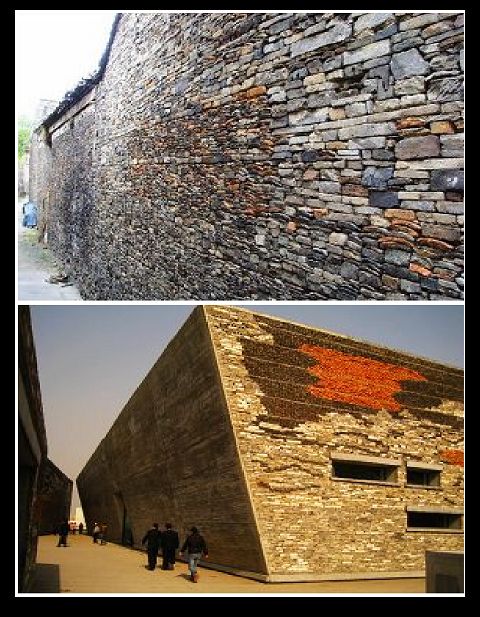
Creative Exhibitions
There five major exhibition halls to fully display the history and culture of Ningbo. The first one is the display of Ningbo history. Four specialties should be pointed out. Firstly, the structure of showing the history bases on the ecological construction which considered the historical development as the Y-axis and the turning points as the X-axis. Secondly, Ningbo museum uses the historical materials to support the display and cultural relics to provide the display. Thirdly, new technologies are used in exhibitions to deepen the understanding and feeling of visitors. Last, the geographic features of Ningbo gave prominence to the theme of ‘water’.
Ecological Construction & Historical Materials
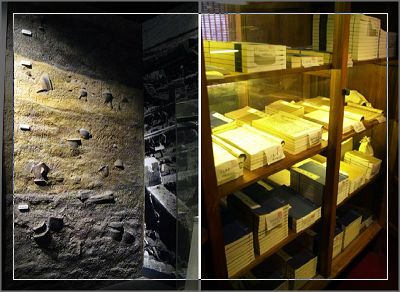
Multimedia & the Theme of Water
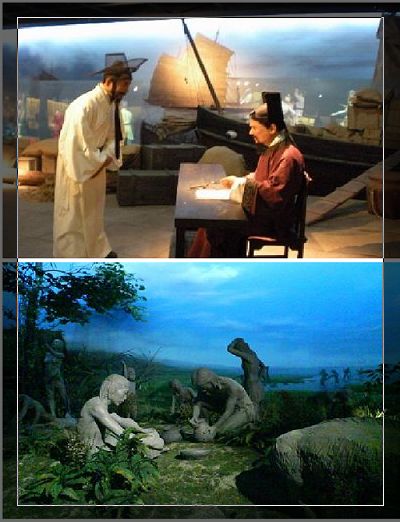
The second exhibition hall is bamboo carvings. This exhibition hall displays traditional culture from both form and content. From the perspective of form, the Chinese traditional method of ‘borrow scenery’ and traditional exhibition shelves is applied in display to heighten visual effects. From the perspective of content, these collections are ‘the most important bamboo carving collection extant in China and is definitely ranked the top level of its kind whether judged by quality and quantity’ ( Shixiang & Jiajin n.d.)
‘Borrow Scenery’ and Traditional Exhibition Shelve
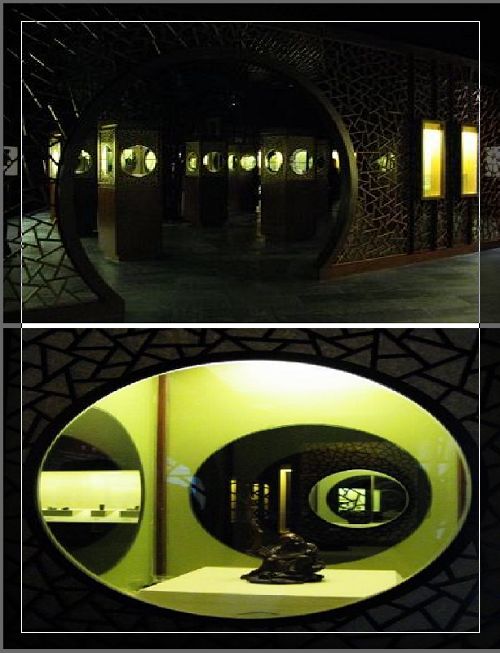
The third exhibition hall is the display of Ningbo customs consisted of Ningbo old-established brands, Ningbo wedding customs, Ningbo houses, Ningbo calendar, Ningbo craftsmanship and Ningbo opera and dialect. All these customs were the hallmark in Ningbo history and culture.
Ningbo Customs.
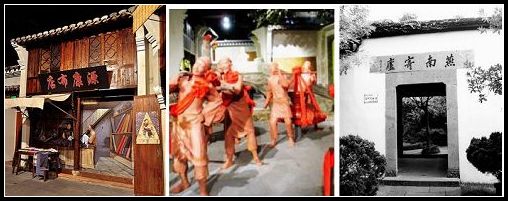

The remaining two exhibition halls are respectively special exhibition of royal jewel and art works donated by Shao keeping. Special exhibitions always changed with the plans of display.
Princes Gold & Silver Works
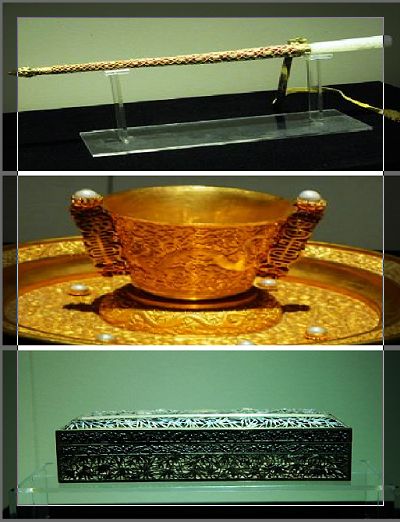
With these creative elements, Ningbo museum has become a particular cultural palace where people understand history and learn more about the world.
Posted: May 4th, 2009 | Author: Shui Jing | Filed under: creative industries, real-estate, theory | Tags: Add new tag, urban network | 1 Comment »
What do the features of spatial cluster or the spatial agglomeration mean? Evaluating with references such as Van to discuss how Ningbo’s creative industry connect with urban development.
Posted: May 4th, 2009 | Author: Fu Hanqing | Filed under: creative industries | Tags: peripheral geography creative production | No Comments »
Be different from North America and Europe, creative clusters of Beijing were always at the edge of the city. These were many factors for this phenomenon. Firstly, experimental artists gathered spontaneously at the outer regions. Secondly, the unstable political situation further made the artists migrate obscure places. Last but not least, the government made an important role. It made comprehensive plans for the distribution of creative clusters in the urban periphery.
There were two modes of ex-urban sprawl. One was village intensification. Local peasants did not have the proprietary rights of land. They just developed it and rented the houses to migrate workers through informal ways. These migrants usually worked in the labor intensive creative industries, such as serving vacation village, constructing art villages and so on. The other was expansive new development areas. These included artist’s villages, art gallery and art districts, software parks, leisure spaces, conference hotels, spas and theme parks.
It should consider of the opportunities and challenges from four perspectives. First of all, the creative industries were scattered to the out regions of the city. At beginning, artists’ choices of renting the edge of the city were because of the low rent. However, with the development of houses and studios at the edge, the phenomenon of luxury housing here were more and more obvious. And the creative production was even controlled by governments and real-estate developers. Fortunately, the cultural diversities in Beijing’s periphery can lead to new understanding and developmental modes for people to periphery. Secondly, Beijing government tolerated migrant workers to reside in the villages which are developed illegally because migrant workers contribute more to the urban economy. Thirdly, international and Chinese labor force congregated in the urban periphery. The collisions of diverse experiences, skills and talents of international and Chinese labor force provided a huge potential for innovation. Fourthly, the combination of the powerful central government and the weak regulatory framework offered opportunities for urban development. The strong government guided the developmental direction and ensured the implement of policies while the weak regulatory framework created chance s for migrant workers to empower themselves, achieving equal rights.
References
Blackwell, Adrian (2008) ‘Inverting the Cultural Map: Peripheral Geographies of Beijing’s Creative Production’, Urban China 33: 48-51.
Posted: May 4th, 2009 | Author: Yao Xiao Xiao | Filed under: real-estate | Tags: advertising, living space | No Comments »
In current Chinese society, house is no longer merely a sweet place for family being together, but also a vital representation of one’s social status. As Zhang (2008) points out, the stratification of urban residential space provides a tangible place for people to seek status recognition and create their cultural milieu. As the new rich in China succeed economically, they still lack a sense of social insecurity and yearn for respect from others. Therefore through the consumption of private property, the invisible socioeconomic differences are externalized. Besides a demonstration of one’s wealth, spatial location is also considered as an implication of one’s lifestyle and taste, at least that what real estate advertising tells people.
References:
Zhang, Li (2008) ‘Private Homes, Distinct Lifestyles: Performing a New Middle Class’, in Li Zhang and Aihwa Ong (eds) Privatizing China: Socialism from Afar, Ithaca: Cornell University Press, pp. 23-40.
Posted: May 3rd, 2009 | Author: Meng Xing | Filed under: waste industries | Tags: political framework, recycling waste | No Comments »
The awareness of a global eco-crisis is growing…
E-waste (from televisions, computers, cell phones and so on) recycling brings poisonous fumes and heavy metals which are harm to human body.
Maxwell and Miller mentioned two major recycling centers (Guiyu in Guangdong Province and Luqiao Qu in Zhejiang province). I also find a paper “Environmental contamination from electronic waste recycling at Guiyu, southeast China†which gives more details about the heavy pollution in Guiyu.
Maxwell and Miller indicated sustainable development which means we preserve the environment in order to using resource to meet human needs not only in the present, but also for future generations.
Actually, Chinese government also claims sustainable development. There is a political framework about E-waste recycling system. In China,Regulation on Waste Imports for Environmental Protection and Management (Interim) was issued in 1996. It points out that imports of e-waste are illegal.
References:
Maxwell, R and Miller, T (2008) ‘Creative Industries or Wasteful Ones?’, Urban China 33: 28-29.
Maxwell, R and Miller, T (2008) ‘Ecological Ethics and Media Technology’, International Journal of Communication 2: 331-353.
The Political Framework in China Impacts on the E-waste Recycling System: http://ewasteguide.info/the_political_framework_in_china_impacts_on_the_e_waste_recycling_system
Leung Anna, Cai Zongwei & Wong Minghung (2005) Environmental Contamination From Electronic Waste Recycling at Guiyu, Southeast China: http://www.springerlink.com/content/g8k452x2542hk200/fulltext.pdf













Recent Comments